ASPIRE Spring 07 - Aspire - The Concrete Bridge Magazine
ASPIRE Spring 07 - Aspire - The Concrete Bridge Magazine
ASPIRE Spring 07 - Aspire - The Concrete Bridge Magazine
Create successful ePaper yourself
Turn your PDF publications into a flip-book with our unique Google optimized e-Paper software.
An underslung<br />
erection truss<br />
was used with<br />
the span-byspan<br />
method of<br />
construction.<br />
Department of Transportation design<br />
manuals do not encompass segmental<br />
bridges. “Some criteria ultimately take<br />
them out of the mix,” he says, such as<br />
needing to allow for deck replacements.<br />
W i t h o u t e x a m p l e s t o v i e w i n<br />
Pennsylvania, turnpike officials went<br />
with FIGG engineers to view examples<br />
in Maine and Boston. <strong>The</strong>y then had<br />
to convince turnpike commissioners, as<br />
well as the local contracting community,<br />
of the benefits. “<strong>The</strong>re was a real<br />
concern that we were excluding local<br />
contractors by creating a design with<br />
which they had no experience,” he says.<br />
Ultimately, the winning bid was secured<br />
by a joint venture between Edward<br />
Kraemer & Sons Inc. of Plain, Wisconsin,<br />
and G. A. and G. F. Wagman, Inc. of<br />
York, Pennsylvania.<br />
<strong>The</strong> segmental design offered key<br />
advantages, explains Jay Rohleder, Senior<br />
Vice President with FIGG. “Segmental<br />
bridges offer an economical approach<br />
because they are constructed quickly<br />
without falsework,” he explains. <strong>The</strong><br />
Susquehanna River is non-navigable,<br />
which also ruled out the option of<br />
transporting components to the site<br />
via barge, he adds. “Economy was<br />
paramount to the selection, as well as<br />
the ability to advance quickly through<br />
the permitting process.<br />
Graham agrees. “A key attraction was<br />
the rapid construction that we saw<br />
was possible with this format,” he<br />
says. “Our goal is to build as fast as<br />
possible, get in, and get out. With the<br />
precast concrete components, we could<br />
work through the winter. It offered the<br />
shortest duration of all bridge types,<br />
and that was a major advantage.” FIGG<br />
created an erection scheme to lead<br />
turnpike officials through the process<br />
and schedule prior to commencing<br />
construction, he notes.<br />
<strong>The</strong> new bridge was constructed parallel<br />
to the existing structure—so closely, in<br />
fact that between less than 1 ft and<br />
no more than 30 ft separate the two<br />
structures. Temporary shoring was<br />
provided at abutments on the east<br />
side, where the bridges are separated<br />
by inches, to maintain fill between the<br />
structures, Rohleder says.<br />
<strong>The</strong> contractor gained access to a<br />
slag pile located just above the east<br />
abutment site, where components could<br />
be cast. After casting and curing, the<br />
precast concrete segments were loaded<br />
onto a low-boy trailer and driven to<br />
the bridge site via an access road. <strong>The</strong><br />
segments were driven onto the bridge<br />
to the segment setter, placed at the<br />
edge of the previously constructed span.<br />
<strong>The</strong> segment setter lifted each segment<br />
off the low-boy trailer and set it onto<br />
the erection truss. A trolley then transported<br />
the segment along the truss.<br />
<strong>The</strong> segments were aligned one by<br />
one, the joints coated with epoxy,<br />
and the segments pulled together<br />
with temporary post-tensioning. This<br />
process continued until the complete<br />
span was assembled. A 6-in.-wide castin-place<br />
closure placement was then<br />
placed at both pier segments. <strong>The</strong><br />
closure placements were allowed to set<br />
overnight prior to post-tensioning the<br />
segments. <strong>The</strong>n the truss was advanced<br />
to the next span. <strong>The</strong> final posttensioning<br />
consisted of eight 27-strand<br />
tendons.<br />
Construction progress was done in three<br />
phases due to specific site logistics,<br />
Graham explains. <strong>The</strong> process began<br />
with the bridge’s east lanes, which<br />
were built out to a central island in<br />
the river. <strong>The</strong>n construction returned<br />
to the east side and the westbound<br />
lanes were built completely across the<br />
river, after which the final half of the<br />
A custom-made segment setter was<br />
used to move the segments from<br />
the low-boy trailer onto the twin<br />
erection trusses.<br />
36 | <strong>ASPIRE</strong>, <strong>Spring</strong> 20<strong>07</strong>

















